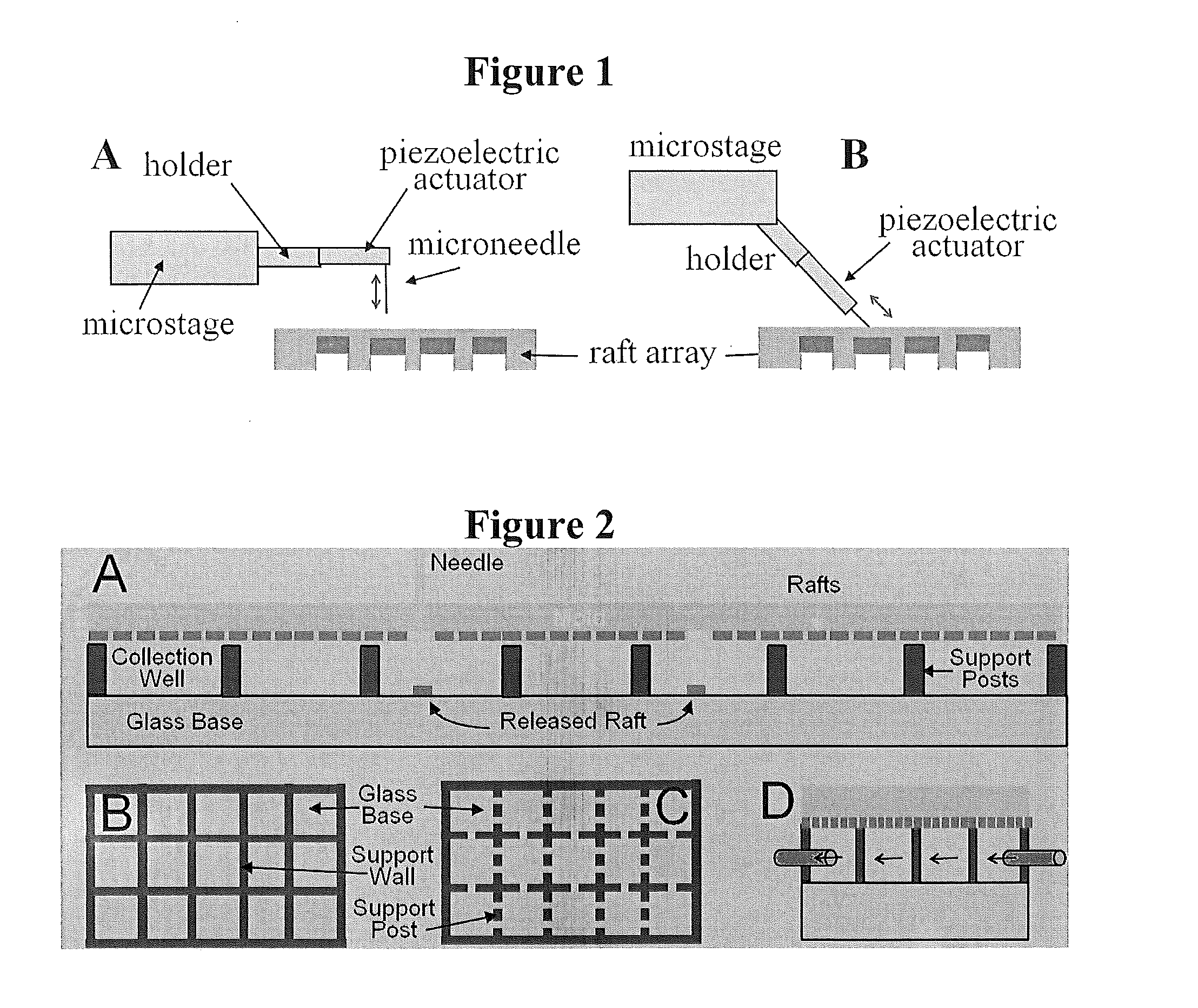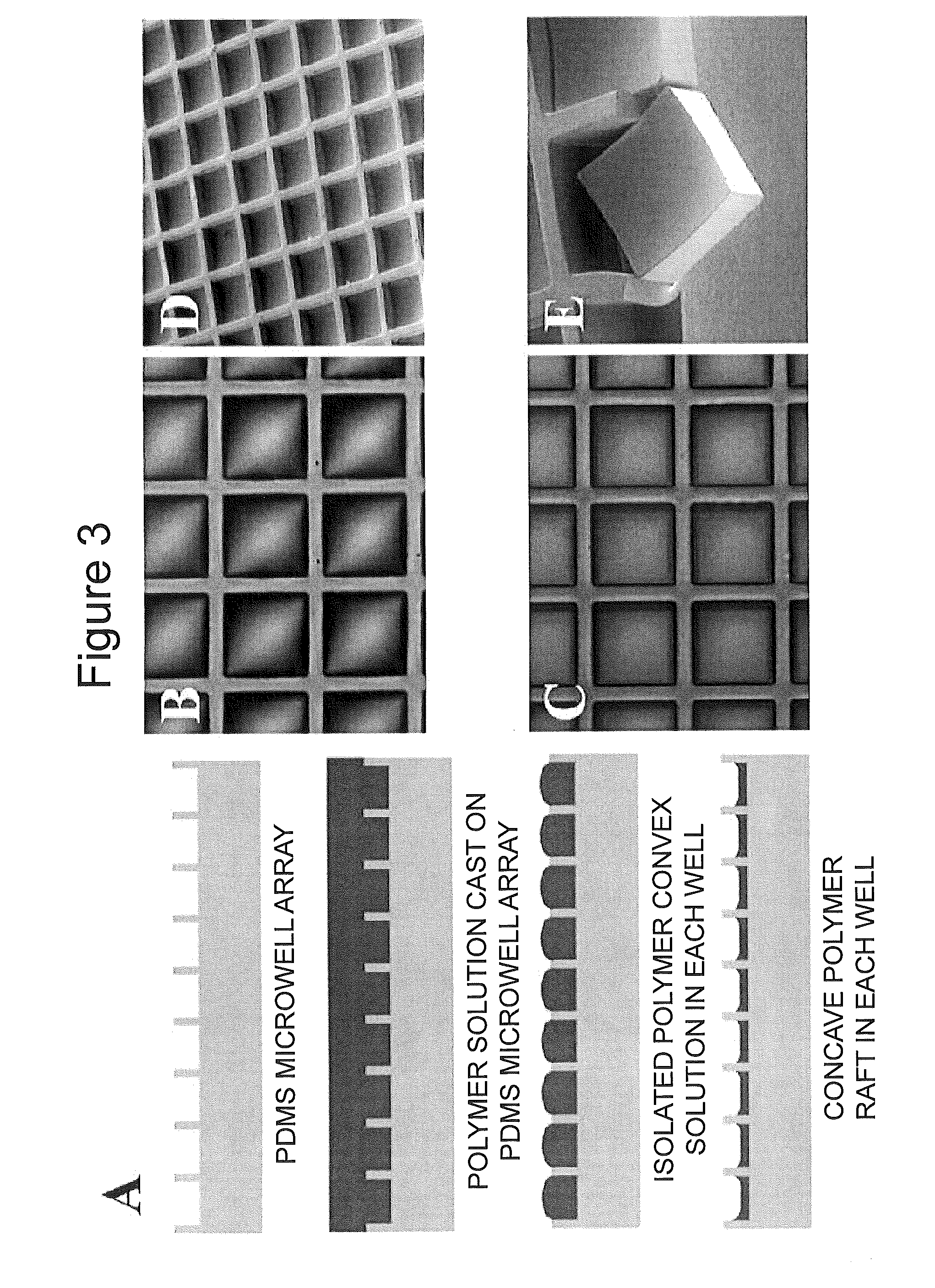Array of micromolded structures for sorting adherent cells
a micro-molded structure and adherent cell technology, applied in the field of adherent cell arrays, can solve the problems of affecting the morphology of cells, and affecting the viability of living cells, so as to achieve the effect of reducing the number of living cells
- Summary
- Abstract
- Description
- Claims
- Application Information
AI Technical Summary
Benefits of technology
Problems solved by technology
Method used
Image
Examples
example 1
[0072]As one non-limiting example of the invention, we describe here an improved technology for creating an array of individually releasable elements which overcomes the above limitations. Instead of fabricating pallets on glass using photolithography and photoresist, we use an array of microwells made from PDMS as the template to micromold the rafts. The micromolded raft contains no photoinitiator and therefore has a low autofluorescence background. The micromolding process does not require any microfabrication tool, so the fabrication becomes extremely simple and inexpensive. Since the raft is located inside the microwell, cells can fall into the microwell and then attach, thus eliminating the necessity of using a virtual air wall or PEG hydrogel wall to localize cell attachment. The most important improvement is to replace the expensive optical system with a low-cost needle release system. A selected raft can be effectively released from the array by the action of a needle insert...
example 2
Coating Microraft Arrays with Biologically Active Molecules
[0113]1. Coating with Extracellular Matrices to Enhance Cell Attachment.
[0114]Extracellular matrices (ECMs), such as collagen, gelatin, laminin and fibronectin, can be coated on the microraft surface to enhance cell attachment. As the first example, a microraft array was coated with 100 μg / mL collagen (type I from rat tail) for 1 h. HeLa cells attached quickly to the microrafts in 2 h (FIG. 10B). As a control, cells didn't attach to the non-coated array at the 2 h time point (FIG. 10A), although they did adhere and spread after 6 h.
[0115]As a second example, in-vitro culture of stem cells generally requires supplying with ECMs to mimic in-vivo environment for self renewal. Matrigel can be coated on the microraft array for culturing stem cells. FIG. 11 shows mouse embryonic stem cell line ES129 cultured on the array at 50 h in the presence of leukemia inhibitory factor (LIF). The array was coated with Matrigel prior to platin...
example 3
Polystyrene and Other Carrier Materials
[0136]An elastomeric PDMS mold (75 mm×50 mm×0.5 mm) was fabricated by casting PDMS on an SU-8 master fabricated by standard photolithography on a glass slide. The SU-8 thickness was 10-250 μm. Approximately 4 g of polystyrene solution (25 wt % in GBL) was added to the PDMS mold (not shown). This amount of solution generates a film of approximately 0.25 mm thickness after baking. Polystyrene solution was found to be dewetting on PDMS surface during baking, causing the solution to shrink. To prevent the dewetting, the PDMS mold was treated with air plasma for 1 min prior to the addition of the polystyrene solution. This treatment did not affect the mold release in the final step. A short (1 min) degas by oil pump was required to remove the trapped air bubbles in the PDMS mold. Since GBL has a high boiling point of 204° C., polystyrene solution did not evaporate or boil during degassing. The polystyrene solution remained as a clear, viscous soluti...
PUM
| Property | Measurement | Unit |
|---|---|---|
| width | aaaaa | aaaaa |
| height | aaaaa | aaaaa |
| thickness | aaaaa | aaaaa |
Abstract
Description
Claims
Application Information
 Login to View More
Login to View More - R&D
- Intellectual Property
- Life Sciences
- Materials
- Tech Scout
- Unparalleled Data Quality
- Higher Quality Content
- 60% Fewer Hallucinations
Browse by: Latest US Patents, China's latest patents, Technical Efficacy Thesaurus, Application Domain, Technology Topic, Popular Technical Reports.
© 2025 PatSnap. All rights reserved.Legal|Privacy policy|Modern Slavery Act Transparency Statement|Sitemap|About US| Contact US: help@patsnap.com



